| Article ID | Journal | Published Year | Pages | File Type |
|---|---|---|---|---|
| 1017990 | Journal of Business Research | 2013 | 8 Pages |
Numerous studies focus on successful clusters to demonstrate that geographic proximity enables collaboration and innovation. Yet, practitioners still need to understand why some clusters fail to collaborate despite their geographic proximity. This longitudinal study investigates an ICT public–private innovation cluster that fails to collaborate and explores how geographic, institutional, organizational, cognitive and social proximities interplay. The findings show that: (1) social proximity is the most important proximity to achieving collaboration; (2) close geographic proximity can be a barrier to social proximity; and (3) geographic distance is seen as an accelerator of entrepreneurship and innovation. These findings contribute to the literature on clusters and innovation by arguing that contexts of high cognitive, organizational, institutional and geographic proximities do not facilitate communication and collaboration. Specifically, geographic proximity can have a negative impact on social proximity. Finally the paper illustrates that clusters created by economic policies are less prone to innovation compared to spontaneous ecosystems emerging from private entrepreneurial initiatives.
